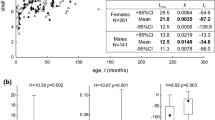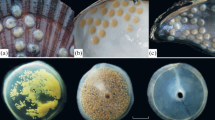Abstract
Data are presented on growth and reproductive rates of Littorina rudis Maton from 3 contrasted habitats: a sheltered saltmarsh, a moderately sheltered boulder shore and an exposed cliff face. Growth was fastest in L. rudis from the moderately sheltered boulder shore, followed closely by snails from the sheltered saltmarsh. Growth was much slower and the asymptotic size much less in L. rudis from the exposed cliff face, this being attributed to the reduced time available for foraging caused by longer and more erratic periods when the substratum dries out. Eggs extracted from the brood chambers of the saltmarsh L. rudis took about 72 d to hatch in the laboratory at 10°C. No seasonal trend was detected in the percentage of sexually mature snails, which fluctuated erratically round about 54 to 99% in each population. Similarly, the ratio of females: males fluctuated erratically about 1.0. The number of eggs and embryos held in the brood chamber peaked in May–June and birth rates (release of young from the brood chamber) peaked in July-August. Following a lull in August, the brood chamber contents were maintained at moderately high levels throughout the winter, whereas the birth rates declined to very low levels. These differences in the seasonal cycle of brood chamber contents and birth rates were probably caused by seasonal differences in embryological development rate and in the propensity of the young to leave the brood chamber. Fecundity increased with parental size and, because of this, the smaller, slower growing exposed-shore L. rudis had much lower potential fecundities than L. rudis from the other shores. However, the size-specific fecundity of the exposedshore L. rudis was about 1.7 times that of L. rudis on the more sheltered shores. This difference was apparently not attributable to smaller young or to a greater capacity of the brood chamber in the exposedshore L. rudis, and must therefore have been caused by higher rates of egg production. 18% of mature females from the boulder shore and 5% of those from the cliff face were oviparous, having a jelly gland in place of the brood chamber.
Similar content being viewed by others
Literature Cited
Berry, A. J.: Some factors affecting the distribution of Littorina saxatilis (Olivi). J. Anim. Ecol. 30, 27–45 (1961)
Fabens, A. J.: Properties and fitting of the von Bertalanffy growth curve. Growth 29, 265–289 (1965)
Hannaford-Ellis, C. J.: Littorina arcana sp. nov.: a new species of winkle (Gastropoda: Prosobranchia: Littorinidae). J. Conch., Lond. 29, p.304 (1978)
Heller, J.: The taxonomy of some British Littorina species, with notes on their reproduction (Mollusca: Prosobranchia). J. Linn. Soc. (Zool.) 56, 131–151 (1975)
Hughes, R. N.: South African populations of Littorina rudis. J. Linn. Soc. (Zool.) 65, 119–126 (1978)
Hughes, R. N.: Growth and reproductive rates of Littorina nigrolineata in North Wales. J. exp. mar. Biol. Ecol. (In press). (1980).
Hughes, R. N. and D. J. Roberts: Comparative demography of Littorina rudis, L. nigrolineata and L. neritoides. (In preparation)
Raffaelli, D. G.: The determinants of zonation patterns of Littorina neritoides and the Littorina saxatilis species complex, 177 pp. Ph.D. thesis, University of Wales 1976
Raffaelli, D. G.: The taxonomy of the Littorina saxatilis species-complex, with particular reference to the systematic status of Littorina patula Jeffrys. J. Linn. Soc. (Zool.) 65, 219–232 (1979)
Ricker, W. E.: Linear regression in fishery research. J. Fish. Res. Bd Can. 30, 409–434 (1973)
Stearns, S. C.: Life history tactics: a review of the ideas. Q. Rev. Biol. 57, 3–47 (1976)
Tantanasiriwong, R.: Culture and energy reserves of larvae of Littorina species, 28 pp. M.Sc. thesis. University of Wales 1974
Walford, L. A.: A new graphic method of describing the growth of animals. Biol. Bull. mar. biol. Lab., Woods Hole 90, 141–147 (1946)
Author information
Authors and Affiliations
Additional information
Communicated by J. Mauchline, Oban
Rights and permissions
About this article
Cite this article
Roberts, D.J., Hughes, R.N. Growth and reproductive rates of Littorina rudis from three contrasted shores in North Wales, UK. Mar. Biol. 58, 47–54 (1980). https://doi.org/10.1007/BF00386879
Accepted:
Issue Date:
DOI: https://doi.org/10.1007/BF00386879




